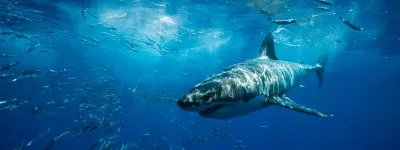According to The Guardian, researchers have discovered several new species of deep-sea shark with the ability to glow in the dark.
Otherwise known as bioluminescence, the ability for organisms living in the deep-sea to produce light is not uncommon, but has never before been documented in the kitefin shark, or the blackbelly and southern lanternsharks. In fact, growing up to 180cm in length, the kitefin shark is now considered the biggest-known luminous vertebrate!

Researchers from the Université Catholique de Louvain in Belgium and the National Institute of Water and Atmospheric Research in New Zealand, collected the sharks from the Chatham Rise, off the east coast of New Zealand, in January 2020.
All three sharks exist at depths between 200 and 1,000-metres deep - often known as the “twilight zone” because sunlight does not penetrate beyond. As a result, inhabitants of the twilight zone appear to stand-out against the surface light when viewed from below, leaving them vulnerable to attack. It is thought that these sharks may use bioluminescence to blend in to the surface light and camouflage themselves from predators below.
Conversely, the largest of the three species - the kitefin shark - has very few predators. Scientists believe this particular species may, in fact, disguise itself while hunting, or to illuminate the seafloor while scouring for food. The paper, published in the Frontiers in Marine Science journal, suggests that further study is needed to prove either theory.
Jérôme Mallefet, lead researcher from the Marine Biology Laboratory of the Université Catholique de Louvain in Belgium, said: “The luminous pattern of the Kitefin shark was unknown and we are still very surprised by the glow on the dorsal fin. Why? For which purpose?”
Whatever the reasons, these new findings are another invaluable piece of the complex deep-sea puzzle.




